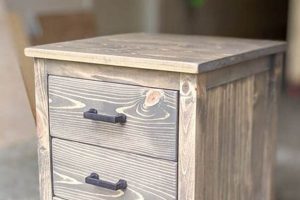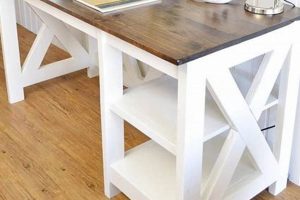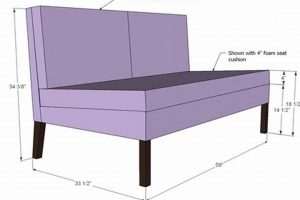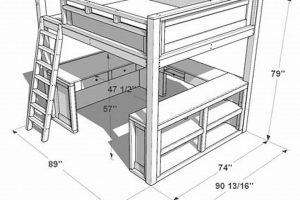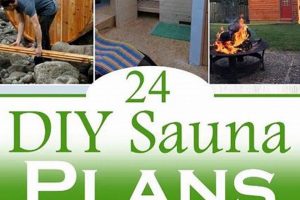The concept involves designs and instructions for constructing a personal heat bathing structure by the individual. This typically encompasses a range of skill levels and construction complexities, from simple, pre-cut kits to elaborate, custom-built structures.
Such endeavors offer potential cost savings compared to professional installation and allow for complete customization to meet specific spatial and aesthetic preferences. Historically, constructing such structures has been a method for individuals to achieve a desired health and wellness experience within their personal environment.
Considerations for these projects include material selection, ventilation requirements, heating source options (wood-burning, electric, infrared), and adherence to local building codes. Further discussion will address these elements in more detail.
Essential Guidance for Construction
This section provides critical advice for those undertaking a self-directed sauna construction project. Adherence to these points can contribute to a safer, more functional, and ultimately more satisfying outcome.
Tip 1: Comprehensive Planning: Prior to commencing any physical work, a detailed plan is essential. This includes precise measurements, material lists, and a thorough understanding of the chosen design. Failure to adequately plan can lead to costly errors and structural deficiencies.
Tip 2: Building Code Compliance: Strict adherence to local building codes is non-negotiable. These codes address safety standards related to electrical wiring, ventilation, and fire resistance. Contact the local building department to ensure full compliance.
Tip 3: Proper Ventilation: Adequate ventilation is critical for both user comfort and structural integrity. Insufficient ventilation can lead to moisture buildup, promoting mold growth and wood rot. Calculate ventilation needs based on the sauna’s size and usage frequency.
Tip 4: Heater Selection and Installation: The heater is a crucial component. Select a heater that is appropriately sized for the sauna’s volume, and ensure it is installed according to the manufacturer’s instructions. Incorrect installation can create a fire hazard.
Tip 5: Material Selection: The choice of materials directly impacts the sauna’s performance and longevity. Opt for durable, heat-resistant woods such as cedar, redwood, or hemlock. Avoid treated lumber, which can release harmful chemicals when heated.
Tip 6: Electrical Safety: Electrical work must be performed by a qualified electrician and adhere to all relevant electrical codes. Grounding, proper wiring, and appropriate circuit breakers are essential for safety.
Tip 7: Insulation Efficiency: Proper insulation is crucial for energy efficiency and maintaining consistent temperatures. Use high-quality insulation materials and ensure a tight seal to prevent heat loss.
Successful implementation relies on thorough planning, diligent execution, and unwavering adherence to safety protocols. A well-executed project enhances property value and provides a valuable amenity for years to come.
With careful attention to these crucial elements, the resulting structure will provide enduring value and enjoyment.
1. Structural Integrity
For self-directed heat bathing structure construction, structural integrity represents a fundamental pillar of success. The design and construction method employed must ensure the sauna can withstand the repeated thermal stress cycles inherent in its operation. This stress arises from significant temperature fluctuations, ranging from ambient levels to upwards of 185F (85C). Deficiencies in structural design or execution directly compromise the safety and longevity of the structure. For example, inadequately supported roofing can lead to collapse under snow load, while improperly joined wall sections can warp or separate due to thermal expansion and contraction.
Structural integrity also dictates material selection. The chosen wood species must possess inherent resistance to decay and warping. Poor material choices, such as using non-kiln-dried lumber or wood unsuitable for high-moisture environments, will accelerate structural degradation. Furthermore, the foundation and framing must be designed to support the weight of the structure and its occupants, preventing settling or shifting that could compromise the sauna’s integrity. A real-world example of neglecting this aspect is evidenced by DIY saunas built on inadequate foundations, which subsequently experience door alignment problems and air leaks due to ground movement.
In conclusion, a focus on structural integrity is paramount in these projects. It is inextricably linked to safety, durability, and overall value. Prioritizing proper design, material selection, and construction techniques ensures a long-lasting and safe heat bathing experience, mitigating potential structural failures. The investment in sound structural practices far outweighs the risks associated with cutting corners or neglecting this crucial aspect.
2. Material Selection
Material selection is a critical determinant in self-directed sauna construction, influencing longevity, safety, and overall operational efficiency. The appropriateness of selected materials directly impacts the performance and lifespan of the structure.
- Wood Species and Heat Resistance
The choice of wood is paramount due to its direct contact with heat and humidity. Softwoods such as cedar, redwood, and hemlock are commonly favored for their inherent resistance to decay, dimensional stability under temperature fluctuations, and low resin content. Hardwoods are generally avoided as they can become excessively hot, pose splintering hazards, and are less resistant to moisture-related degradation. The selection of an appropriate wood species directly influences the safety and comfort of the sauna user.
- Insulation Materials and Heat Retention
Effective insulation is essential for maintaining consistent temperatures and reducing energy consumption. Fiberglass batts, mineral wool, and rigid foam boards are commonly employed. The R-value (thermal resistance) of the insulation directly impacts the sauna’s ability to retain heat, influencing operational costs. Improper insulation leads to increased energy usage and temperature instability, undermining the sauna’s functionality. An example is the use of inadequate insulation, which results in significant heat loss and higher heating costs.
- Vapor Barrier and Moisture Control
A vapor barrier is crucial in preventing moisture from penetrating the walls and ceiling, which can lead to mold growth and structural damage. Aluminum foil or specialized vapor barrier membranes are typically used. Proper installation, ensuring complete coverage and airtight seals, is essential for preventing moisture-related problems. Neglecting the vapor barrier inevitably results in premature degradation of the sauna’s structural components.
- Fasteners and Corrosion Resistance
Fasteners, including nails, screws, and bolts, must be corrosion-resistant to withstand the humid environment. Stainless steel or coated fasteners are recommended to prevent rust and maintain structural integrity. The use of standard, non-corrosion-resistant fasteners leads to premature failure and potential structural weakness. A common example is the rusting of standard nails, which compromises the stability of wall panels.
Therefore, informed material selection is an indispensable element in these projects. Proper choice directly correlates with the sauna’s durability, operational efficiency, and safety. These choices are long-term investments and impact the sauna’s overall life cycle costs and usability. Selection requires careful evaluation of material properties, code compliance, and budget considerations.
3. Heating efficiency
Heating efficiency is a critical element of sauna construction. It represents the effectiveness with which a sauna maintains the desired temperature while minimizing energy consumption. In these projects, heating efficiency directly impacts operational costs, user comfort, and environmental impact. Inefficient heating leads to higher electricity bills, prolonged heating times, and inconsistent temperatures, diminishing the overall sauna experience. For instance, a poorly insulated sauna requires significantly more energy to reach and maintain a specific temperature compared to a well-insulated one. The choice of heater, insulation materials, and overall design directly contributes to or detracts from heating efficiency.
Sauna design significantly influences heating efficiency. Proper sealing of all joints and seams minimizes heat loss through air leaks. The strategic placement of the heater relative to seating and ventilation points promotes even heat distribution. For example, locating the heater near the floor and positioning benches at varying heights capitalizes on natural heat stratification. Moreover, employing a smaller sauna volume, strategically reducing ceiling height, diminishes the space requiring heating, thus increasing efficiency. A real-world illustration shows that a smaller, well-insulated sauna heats up faster and consumes less energy than a larger, poorly insulated one, even with the same heater. Careful attention to these design considerations is crucial for optimizing heating performance.
Heating efficiency in sauna construction is not merely about minimizing energy use; it’s about creating a sustainable and enjoyable experience. By prioritizing insulation, air-tight construction, appropriate heater selection, and thoughtful design, individuals can create heat bathing environments that are both cost-effective and environmentally responsible. Failure to address heating efficiency results in diminished user satisfaction, higher operational expenses, and increased environmental impact. A holistic approach, therefore, is essential for a successful and sustainable sauna project.
4. Ventilation design
Ventilation design is a critical, often underestimated, component within sauna construction. Its impact extends beyond user comfort, directly influencing structural integrity and safety. An inadequately ventilated sauna exhibits elevated humidity levels, fostering mold growth and accelerating wood decay. This compromises the structural stability of the building and presents potential health hazards. The integration of effective ventilation strategies into design plans is, therefore, not optional but essential.
Efficient ventilation facilitates air exchange, removing moisture and replenishing oxygen. The location and size of vents, typically positioned both high and low within the structure, determine the airflow pattern. Lower vents allow for the intake of fresh air, while higher vents facilitate the exhaust of warm, moisture-laden air. The size and placement of these vents must be calculated in relation to the sauna’s volume and intended usage frequency. A common oversight is failing to account for the stack effect, which can result in excessive airflow and difficulty maintaining desired temperatures. Balancing ventilation needs with heat retention strategies is a critical design challenge.
The practical implications of proper ventilation design are significant. By incorporating appropriate ventilation strategies into the planning phase, long-term maintenance costs are reduced, and the lifespan of the sauna is extended. Furthermore, the health and safety of users are prioritized by mitigating the risks associated with excessive humidity and oxygen depletion. Addressing ventilation as a fundamental element, rather than an afterthought, ensures that the structure is both functional and sustainable, providing a safe and enjoyable heat bathing experience.
5. Safety compliance
Safety compliance represents an indispensable element in self-directed sauna construction. Failure to adhere to established safety standards can result in significant risks, ranging from fire hazards and electrical shock to structural collapse and health complications. These risks necessitate a thorough understanding and diligent application of relevant safety codes and best practices throughout the entire construction process.
- Electrical Safety and Wiring Standards
Electrical safety is of paramount concern, given the high temperatures and potential for moisture exposure. All wiring must conform to local electrical codes, employing appropriately sized conductors, grounded circuits, and moisture-resistant materials. Improper wiring poses a severe fire hazard and increases the risk of electrical shock. Examples include using standard household wiring instead of high-temperature-rated wiring or neglecting to properly ground the electrical system, creating a potentially lethal environment.
- Heater Installation and Clearance Requirements
The heater, whether electric or wood-burning, must be installed according to the manufacturer’s specifications and in compliance with fire safety regulations. Sufficient clearance must be maintained between the heater and combustible materials to prevent fire. Overlooking these clearances, even by a small margin, significantly elevates the risk of fire ignition. Real-world scenarios show that inadequate clearances often lead to overheating and subsequent combustion of nearby wood.
- Ventilation and Air Quality Standards
Adequate ventilation is crucial for maintaining air quality and preventing the buildup of carbon monoxide, particularly in wood-burning saunas. Ventilation systems must be designed to provide sufficient fresh air exchange and exhaust combustion gases safely. Insufficient ventilation can result in carbon monoxide poisoning, posing a severe health risk to sauna users. Ensuring compliance with ventilation standards is, therefore, non-negotiable.
- Structural Integrity and Load-Bearing Capacity
The sauna’s structure must be capable of supporting its own weight, as well as the weight of occupants and any potential snow loads. Structural elements, including framing and roofing, must be designed and constructed to meet or exceed local building codes. A failure to adhere to these standards can result in structural collapse, posing a serious threat to individuals within the sauna. Neglecting proper load calculations often results in weakened structures prone to failure.
The preceding facets underscore the critical importance of safety compliance in self-directed sauna projects. Adherence to established safety standards not only minimizes risks but also ensures the longevity and functionality. Therefore, rigorous attention to detail and a proactive approach to safety are essential for a successful and safe construction process. Prioritizing these aspects leads to a durable structure and peace of mind.
6. Cost management
Cost management represents a central tenet of personal sauna construction. The choice to undertake such a project frequently stems from the desire to reduce expenses associated with professional installation or commercial sauna access. Effective cost management necessitates a comprehensive approach, encompassing material sourcing, labor allocation, and contingency planning. Inadequate cost control can rapidly escalate project expenses, negating the anticipated savings and potentially exceeding the cost of alternative solutions.
The impact of material selection on project expenses is substantial. Choosing readily available and cost-effective materials, such as locally sourced lumber, can significantly reduce overall costs. Conversely, selecting exotic or imported woods substantially increases the material budget. Labor costs represent another key area for cost management. Individuals with construction experience may choose to perform most of the work themselves, thereby minimizing labor expenses. However, relying on unqualified labor or underestimating the time required for each task can lead to delays and additional costs. Contingency planning is also critical. Unexpected issues, such as material price increases or unforeseen structural complications, can arise during construction. Allocating a percentage of the budget to cover these contingencies can prevent financial disruptions.
The successful execution of the project hinges on the capacity to efficiently manage costs, integrating various factors of the planning and execution. This ensures financial objectives are achieved, while the project yields its intended benefits. Neglecting this crucial aspect exposes the project to economic vulnerability, possibly leading to a compromised or abandoned structure. Therefore, vigilant financial oversight from inception to completion is of paramount importance.
7. Aesthetic appeal
In the context of individual sauna construction projects, aesthetic appeal represents more than mere visual ornamentation; it directly influences user experience and long-term satisfaction. While functionality and safety are paramount, the visual characteristics of the structure contribute significantly to its perceived value and the overall enjoyment of the bathing ritual. The interplay between design and aesthetics is a critical consideration for individuals pursuing self-directed construction, necessitating a balance between practical requirements and personal preferences. The aesthetic choices made during the design phase directly affect the sauna’s integration with its surrounding environment and its perceived value as a personal retreat.
Considerations for aesthetic enhancement often involve material selection, lighting design, and spatial arrangement. The choice of wood species, for instance, not only impacts structural integrity but also influences the sauna’s visual warmth and character. The use of clear cedar, with its light color and tight grain, creates a different aesthetic than the darker, more rustic appearance of redwood. Lighting design, incorporating elements such as concealed LED strips or strategically placed sconces, can enhance the ambiance and create a more relaxing atmosphere. The spatial arrangement of benches and other features should prioritize both functionality and visual harmony. An example would be the incorporation of a picture window to provide a view of the surrounding landscape, integrating the sauna experience with the natural environment. The arrangement of benches in tiers, maximizing space utilization while offering varied seating options, is another practical aesthetic consideration.
Aesthetic appeal, therefore, is an integral component of self-directed sauna construction. The pursuit of aesthetically pleasing design is not a superfluous addition but rather an essential element that contributes to user satisfaction and elevates the overall value of the structure. Prioritizing aesthetic considerations, alongside practical requirements, ensures a final product that is both functional and visually appealing, ultimately enhancing the sauna experience. Ignoring these considerations may compromise the anticipated benefits and diminish the project’s lasting value.
Frequently Asked Questions
This section addresses common inquiries regarding sauna construction, providing concise and authoritative answers to facilitate informed decision-making.
Question 1: Are specialized skills required to undertake such a project?
While prior construction experience is beneficial, it is not strictly mandatory. Success relies more heavily on meticulous planning, adherence to building codes, and a willingness to learn. Specific tasks, such as electrical wiring, may necessitate the engagement of qualified professionals.
Question 2: What permits are typically required for sauna construction?
Permit requirements vary depending on local regulations. Generally, building permits are required for new structures or significant alterations to existing structures. Contact the local building department to determine specific requirements for the intended project.
Question 3: How much can be saved by constructing a sauna versus purchasing a pre-built model?
Potential cost savings depend on factors such as design complexity, material choices, and labor costs. Substantial savings are achievable by performing the majority of the work and sourcing materials directly. However, hidden costs, such as tool rentals and unexpected complications, must be factored into the budget.
Question 4: What are the primary considerations for heater selection?
The heater’s size, power source (electric or wood-burning), and safety features are primary considerations. The heater’s output must be appropriately sized for the sauna’s volume. Electric heaters offer convenience, while wood-burning heaters provide a traditional experience. Safety features, such as overheat protection and automatic shut-off, are essential.
Question 5: What is the optimal wood type to minimize warping in the extreme climate?
Softwoods like cedar, redwood, and hemlock are dimensionally stable and naturally resistant to decay. Their properties minimize warping from constant use. Kiln-dried options are crucial to ensure minimized warping in heat.
Question 6: What can one expect regarding the longevity of a DIY sauna build?
The lifespan depends largely on the quality of construction, materials used, and maintenance practices. With proper design, construction, and upkeep, a self-constructed sauna can provide decades of use. However, neglecting maintenance or using substandard materials will significantly shorten its lifespan.
Successful execution relies on diligent planning, meticulous execution, and an unwavering commitment to safety. A well-constructed sauna provides enduring value and improves living.
Further discussion will address maintenance practices and troubleshooting common sauna issues.
Conclusion
This exploration of these documents has elucidated the multifaceted considerations inherent in such a project. From initial design to final implementation, the need for meticulous planning, code compliance, and a comprehensive understanding of materials and construction techniques has been highlighted. Successfully navigating the complexities of self-directed sauna construction requires a significant investment of time, effort, and resources.
The information presented serves as a foundational guide for those contemplating such an undertaking. However, independent research and consultation with qualified professionals are strongly recommended. The decision to engage in self-directed construction should be made with a full awareness of the associated challenges and responsibilities. With careful planning and diligent execution, the realization of a personal sauna remains an attainable goal.


